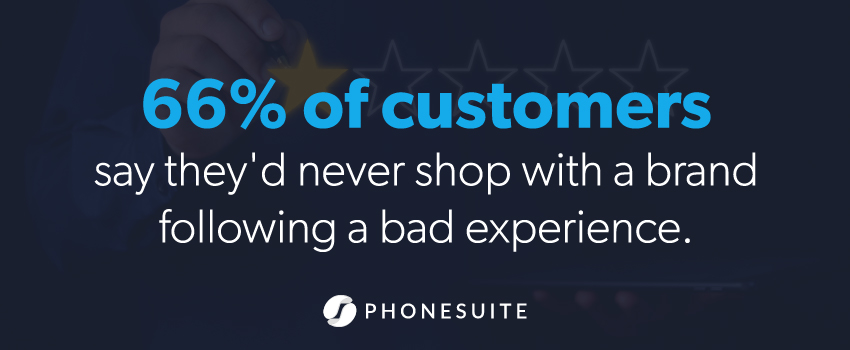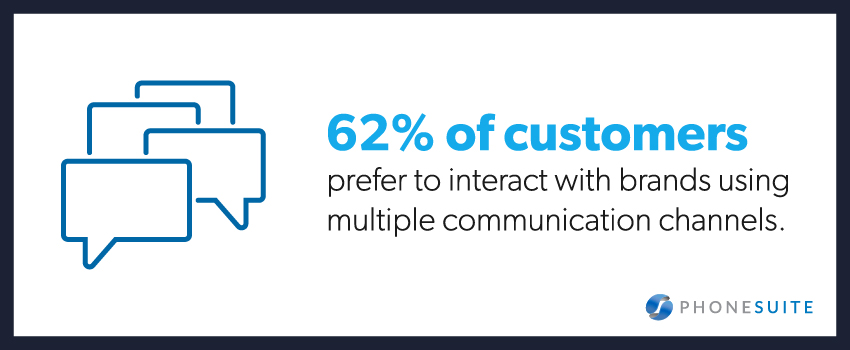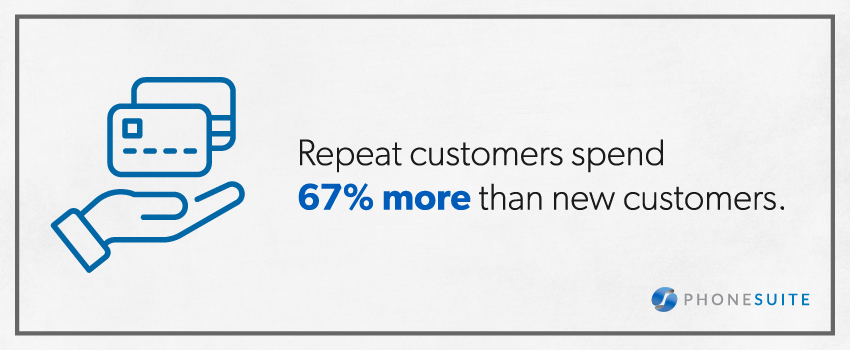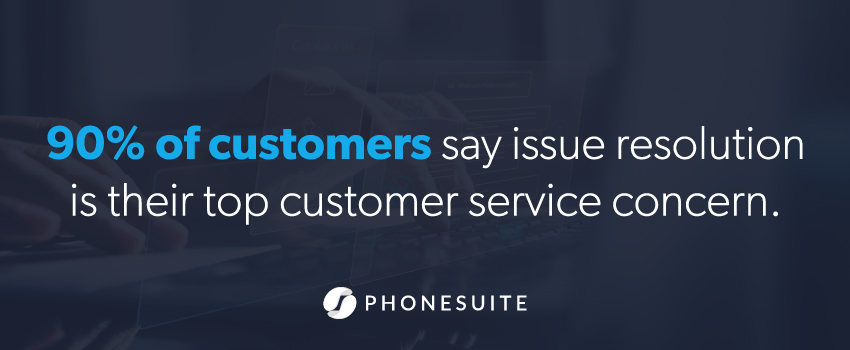In today’s always-on world, businesses need to be available 24/7 to interact with customers across a variety of channels. Modern customers expect fast, convenient service whenever and however they want to reach out, which is why creating exceptional customer experiences is so important.
Delivering a superior customer experience can improve loyalty, advocacy, and revenue, with repeat customers spending 67% more than new customers.1 49% of customers said they had more bad customer service experiences over the past year than in 2022.2 And as 66% of consumers state they’d never shop with a brand following a bad experience,3 improving the quality of service your contact center provides should be a top priority.
In this blog, we’ll share everything business leaders need to know about elevating the contact center experience to better meet customer expectations.
What Is a Contact Center?
A contact center is a centralized customer engagement hub that enables interactions between a company and its customers across multiple channels, such as phone, email, chat, text, social media, and more. Contact centers handle customer inquiries related to support, technical assistance, billing issues, and sales. They are staffed by customer service representatives, who are agents focused on assisting customers throughout the entire customer lifecycle.
What Are the Differences Between Contact Centers and Call Centers?
While the terms “contact center” and “call center” are sometimes used interchangeably, there are some significant differences between the two. Primary differences include:
Service Channels
Call centers only handle voice interactions over the phone, while contact centers offer support across a variety of digital and voice channels. This allows customers to connect however is most convenient for them rather than being limited to just phone calls – a must, considering 62% of customers prefer to interact with brands using multiple communication channels.4 It also enables contact centers to provide a smoother, more cohesive experience as customers move between channels.
Infrastructure
Call centers tend to have more basic, voice-focused infrastructure centered around phone calls. Contact centers utilize advanced cloud-based infrastructure to enable omnichannel support. Cloud-based contact centers provide more flexibility, scalability, and integration capabilities compared to on-premises call centers, enabling quick adaptation as new digital channels emerge.
Customer Insights
Contact centers gather richer customer data and insights than call centers because they track interactions across multiple customer touchpoints and channels. Having this unified view of each customer’s history, preferences, and prior issues allows agents to deliver much more personalized and contextual service experiences.
Agent Skills
Call center agents focus solely on customer communication skills to handle phone-based inquiries and conversations properly. Contact center agents need a broader skill set to provide seamless support across various digital and voice communication channels that customers use. This typically includes everything from chatbot training to understanding how to communicate effectively over text, video, and social media.
Customer Experience vs. Customer Service
The customer experience encompasses every interaction and touchpoint a customer has with a brand, including awareness, discovery, purchase, use, and support. Customer service is only one part of the customer experience focused specifically on support and issue resolution.
Customer experience and customer service overlap and influence each other. Effective customer service leads to a positive customer experience, which in turn reduces the volume of customer service inquiries and issues. However, they aren’t the same thing.
While customer service aims to address specific support issues, customer experience is about delivering end-to-end, personalized interactions and shaping the overall customer relationship and perception of a brand. It includes the complete customer journey and all touchpoints before and after individual customer interactions. That’s why businesses need to not only deliver excellent customer service at the contact center level, but also a seamless experience across every touchpoint.
What Is Contact Center Experience?
The contact center experience refers to the overall quality of interactions that customers have when reaching out to a company’s contact center on any channel. It reflects how easy or difficult it is for customers to connect with support teams and resolve their issues.
The contact center experience directly impacts customer satisfaction, loyalty, and retention. A positive contact center experience means issues get resolved efficiently with minimal customer effort. Negative experiences involve long hold times, unresolved issues, poor agent training, and fragmented, inconsistent support across channels.
Why Is Contact Center Experience Important?
Delivering an exceptional contact center experience should be a top priority, as it impacts multiple areas of your business. An improved contact center experience can:
Improve Customer Relationships
One survey found that the majority (90%) of customers considered issue resolution to be their top customer service concern.5 By improving the contact center experience, you can strengthen relationships with loyal customers through faster issue resolution and lower effort to improve retention and lifetime customer value.
Reduce Cost to Serve
Poor customer experiences cost businesses worldwide $3.7 trillion annually – a 19% increase from 2023.6 Lengthy, convoluted contact center experiences with repeated callbacks and unresolved issues drive up operating costs. Optimizing for faster resolution and decreased transfer rates lowers the cost of serving customers and improves profit margins.
Generate Positive Recommendations
A 2023 survey found that 45% of consumers were likely to tell friends and family about a very good experience, while 50% would share a very bad experience.7 Thus, the contact center experience shapes customer perceptions that get amplified through word-of-mouth.
Types of Contact Centers
There are several different models of contact centers, each of which can provide a different customer service experience for your customers. The primary types of contact centers include:
Inbound Contact Centers
Inbound contact centers handle only incoming customer inquiries that come in via phone, email, chat, web forms, social media, and other inbound channels. The customer experience revolves around customer service representatives quickly resolving customer concerns or complaints when they reach out.
Outbound Contact Centers
An outbound contact center focuses on making outgoing calls or messages to customers, typically for telemarketing, sales, or collections. The customer experience involves contact center agents conducting shorter, purposeful outreach aimed at solving specific customer needs.
Business Process Outsourcing (BPO) Contact Centers
BPO centers are third-party providers that contract out their contact center services for other companies. These contact centers try to create a customer experience that mirrors the brand they represent.
Multichannel Contact Centers
A multichannel contact center allows customers to reach out to a company’s customer service team through channels like phone calls, email, and chat. However, customer interactions are often siloed rather than integrated across every channel.
Omnichannel Contact Centers
Omnichannel contact centers provide a fully integrated experience no matter which channel a customer uses. They allow customers and agents to move between voice and other channels while capturing each interaction, enabling contact center agents to provide more personalized customer service.
7 Best Practices to Improve Your Contact Center Experience
There are many strategies your organization can implement to optimize the contact center experience your customer service agents deliver to customers, including:
1. Collect and Analyze Customer Feedback
Gathering customer feedback needs to go beyond just post-interaction surveys. While those are valuable, you should also actively monitor social media channels, review sites, customer communities, and any other places where customers discuss their experiences with your brand. Natural language processing and AI-powered voice analytics can help surface insights from these unstructured customer data sources at scale.
It’s also important to collect customer feedback across all stages of the journey, not just after contact center interactions. Customers may have pain points or frustrations earlier in their journey that eventually lead them to contact your agents. Having visibility into those upstream customer issues allows you to be more proactive about remediation.
2. Track Contact Center Performance Metrics
When tracking standard contact center metrics, be sure to analyze them through different lenses, such as channel, product/service, customer segment, and agent. This granular view helps identify specific areas of strength or vulnerability. You can then dig deeper through practices like speech and text analytics to understand root causes.
Don’t just look at performance backward; correlate metrics to operational data to predict future outcomes and prioritize areas of focus. For example, if you can anticipate a dip in customer satisfaction due to an increase in customer inquiries about a new product, you can staff up and ensure agents are trained on that product beforehand.
3. Map Out the Ideal Experience
Customer journey mapping should involve stakeholders from across functions like marketing, sales, service, IT, finance, and product teams. Each of these groups has a unique vantage point into different stages of the journey that are valuable to incorporate.
A customer journey map should chart out all potential paths a customer could take, not just the ideal golden path you want them to follow. Understanding where journeys break down or where hand-offs occur between departments allows you to design a more unified customer experience.
4. Implement Continuous Training and Coaching
In addition to scheduled training, implement a process for automatically triggering personalized coaching based on interaction analytics. For example, if conversation intelligence software detects an agent is struggling with empathy on certain call types, they can be enrolled in empathy training modules. Or if an agent is mishandling compliance procedures, tailored policy coaching can be assigned.
The best training approaches use real recordings of customer service interactions as examples, not just generic e-learning modules. Having contact center agents review their own calls and get real-time feedback is proven to be more effective. You can also gamify coaching by creating leaderboards and opportunities for agents to coach each other.
5. Leverage AI and Automation
Contact centers can use artificial intelligence and automation technologies to improve the agent and customer experience alike. AI-powered virtual assistants and chatbots handle initial customer inquiries and triage, automating simple requests so your employees can focus on issues that require a human touch. AI analytics can instantly transcribe and analyze customer conversations to surface insights, automate quality assurance scoring, and provide real-time guidance to agents on the best way to handle each interaction.
Robotic process automation (RPA) can also help by automating repetitive back-office tasks like data entry, allowing agents to be more productive and efficient. AI and automation don’t replace human agents but augment them by handling low-complexity work so they can focus on high-value activities that customers appreciate.
6. Deliver Consistent Support
Part of delivering consistent support is using omnichannel engagement hubs to blend all interaction history and customer context in one interface for contact center agents, no matter which channels a customer started on. This prevents customers from feeling like they’re being passed around to different departments when they switch channels.
A robust knowledge management strategy is also critical, with a centralized and up-to-date knowledge base that serves as a single source of truth for policies, product details, and approved messaging across all channels and departments.
7. Listen to Your Agents’ Feedback
Create a culture of feedback where your agents feel comfortable speaking up and are truly listened to. Celebrate examples where their input led to positive changes so they see the impact, and clearly outline protection against retaliation for voicing concerns.
In addition to capturing feedback through surveys and focus groups, give agents the ability to easily submit ideas through chatbots or always-on channels. Look for ways to incorporate agent ideas into your processes for continuous improvement methodologies.
Essential Contact Center Technology Solutions
Achieving a superior contact center experience requires the right technology. Some essential contact center software for improving your customer and agent experiences include:
Customer Relationship Management
Customer relationship management (CRM) systems consolidate all customer data and interactions into one centralized platform. This provides agents with a complete view of the customer journey to personalize service and respond more effectively. CRMs integrate with contact center software to capture data from every touchpoint.
Conversation Intelligence
Conversation intelligence refers to AI-powered tools that track customer interactions across all channels. By analyzing every conversation, contact center managers can identify areas needing improvement and provide agents with the support they need to deliver better customer service.
Live Chat and Chatbots
Live chat enables customers to quickly connect with agents when needed, while chatbots automate responses to common questions through self-service. Modern chatbots leverage AI for natural conversations, allowing customers to communicate with virtual assistants in a conversational manner. This technology provides customers with instant access to information and support, ultimately reducing wait times and improving overall satisfaction.
Quality Management
Quality management software enables businesses to monitor, record, score, and provide feedback on agent interactions rather than just random samplings. This approach helps maintain performance standards and ensures consistent service quality across all customer interactions.
Smart Callback
Smart callback solutions allow customers to request a callback from the next available agent rather than waiting on hold. This feature eliminates a major frustration point for customers by ensuring they don’t have to stay on the line or risk losing their place in the queue.
Employee Experience Management
Employee experience management platforms enable organizations to gather agent feedback, analyze effort and performance scores, and offer continuous coaching. Optimizing the employee experience helps businesses improve the digital experience for agents, which in turn leads to increased customer satisfaction scores.
Digital Behavior Analytics
Digital behavior analytics solutions track and analyze how customers interact with your website, apps, and self-service portals. This analysis identifies areas of confusion or drop-off points that drive unnecessary contact center volume. By understanding customer needs, businesses can optimize their digital channels to reduce the need for customers to contact support teams.
Self-Service Tools
AI-powered knowledge bases, virtual agents, online communities, and other self-service resources help reduce simple customer queries, allowing agents to focus on high-touch problems. These tools make it easy for customers to find answers and resolve issues independently, improving efficiency and reducing the workload on contact center agents.
Top Contact Center Performance Metrics to Track
Tracking the right metrics is vital for gaining visibility into your contact center’s performance. By consistently tracking and analyzing the metrics below, contact center leaders can better understand the experiences their teams are delivering, identify vulnerabilities, prioritize issues, and determine the impact of their improvement initiatives over time.
- Net Promoter Score (NPS®): NPS measures customer loyalty by prompting them to state how likely they are to recommend your product, service, or company to others on a 0-10 scale. For contact centers, NPS indicates the broader perception of the service experience and can help gauge the impact of loyalty on your operations.
- Customer Satisfaction (CSAT): CSAT asks customers to score their satisfaction with a particular brand interaction, product, or service through a rating scale or open-ended feedback. For contact centers, CSAT surveys are typically triggered after service interactions to gauge how well the agent met the customer’s needs.
- First Contact Resolution (FCR): Customer inquiries that are fully resolved during the first interaction without any follow-up required are known as the first contact resolution (FCR) rate. A high FCR rate indicates your agents are effectively addressing customer needs right away.
- Average Resolution Time (ART): This metric tracks the average time it takes from when a customer first reaches out to support until their issue is fully resolved, even if it spans multiple interactions. A high ART could mean you have unnecessarily complex hand-offs between teams, a lack of workforce capacity during peak periods, or other workflow bottlenecks causing delays.
- Average Handle Time (AHT): AHT measures the average duration of each customer interaction from start to finish, including any hold times and after-call work required by the agent. Lower AHT implies more efficient service delivery, but you don’t want AHT to drop so low that it impacts quality and resolution rates.
- Customer Effort Score (CES): CES quantifies the amount of effort a customer has to put forth to get their question answered or the issue resolved based on their direct feedback. Low scores indicate a smooth, easy experience for the customer.
- Customer Sentiment: Analyzing customers’ sentiments during interactions can provide insight into how well your contact center is meeting expectations. AI speech analytics and natural language processing can automatically categorize the emotional tone of conversations based on the words, phrases, inflections, and context used by customers.
Optimize Your Contact Center Experience With PhoneSuite
Today’s customers demand fast, frictionless service on their preferred communication channels. To accomplish this, contact centers need robust technology solutions that empower agents with the right information and tools, provide comprehensive visibility into performance through advanced analytics, and facilitate improvement through training, coaching, and process optimizations.
Phonesuite’s contact center solution delivers all the tools your hospitality business needs to transform guest services. Our AI-powered contact center ensures guests receive consistent quality service, drives employee accountability, and provides visibility into your operations with state-of-the-art live dashboards, reporting, and real-time alerting. Contact Phonesuite today to get started with a contact center solution that helps your teams deliver exceptional customer service.
Sources:
- https://www.semrush.com/blog/customer-retention-stats
- https://semrush.com/blog/customer-retention-stats
- https://www.sitecore.com/company/newsroom/press-releases/2022/05/us-brand-authenticity-report
- https://squaretalk.com/omnichannel-statistics
- https://www.zippia.com/advice/call-center-statistics
- https://www.forbes.com/sites/shephyken/2024/03/17/bad-customer-service-could-cost-more-than-37-trillion
- https://www.xminstitute.com/research/global-consumer-feedback-channels-2024



